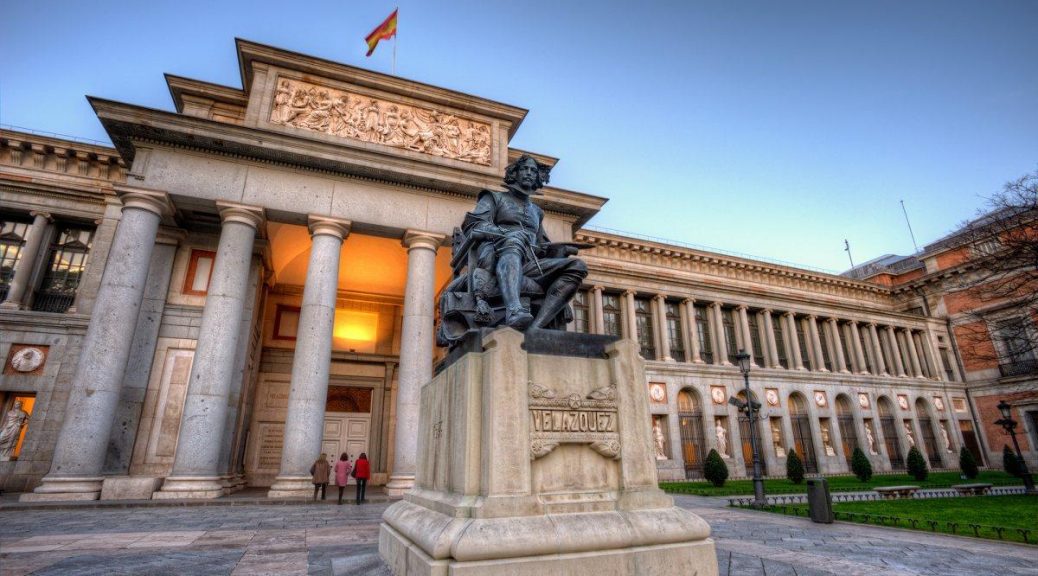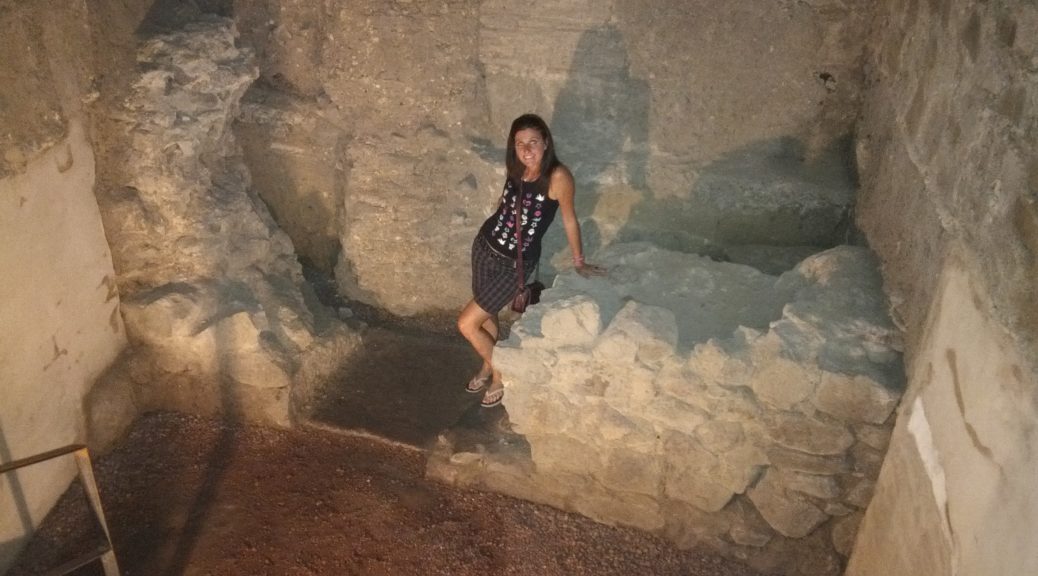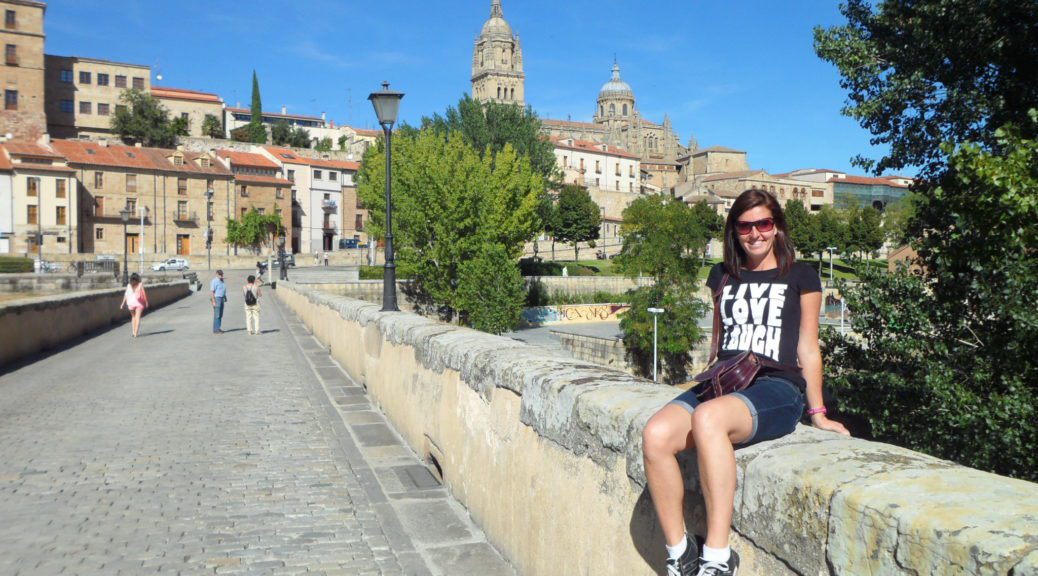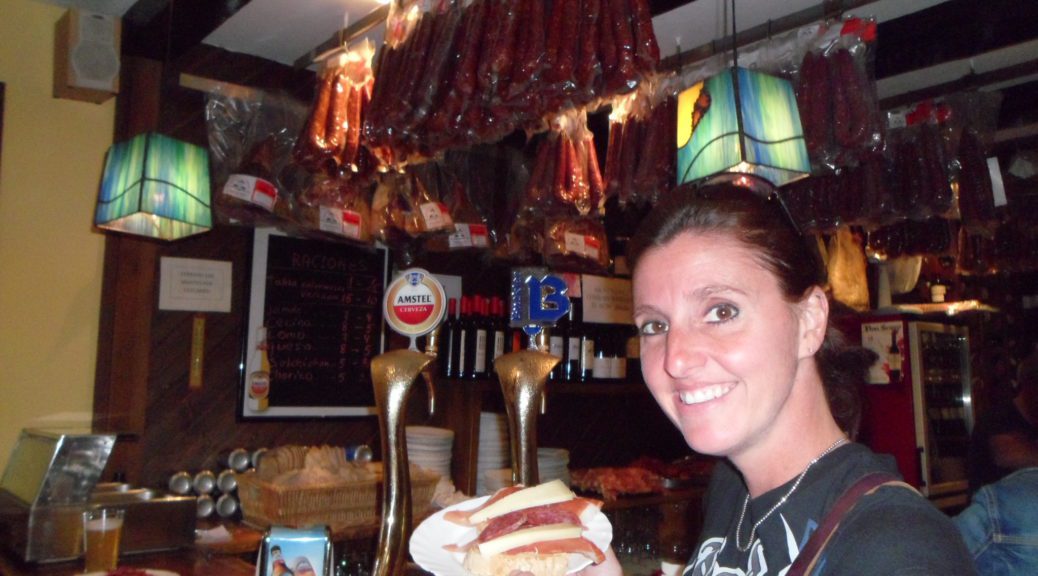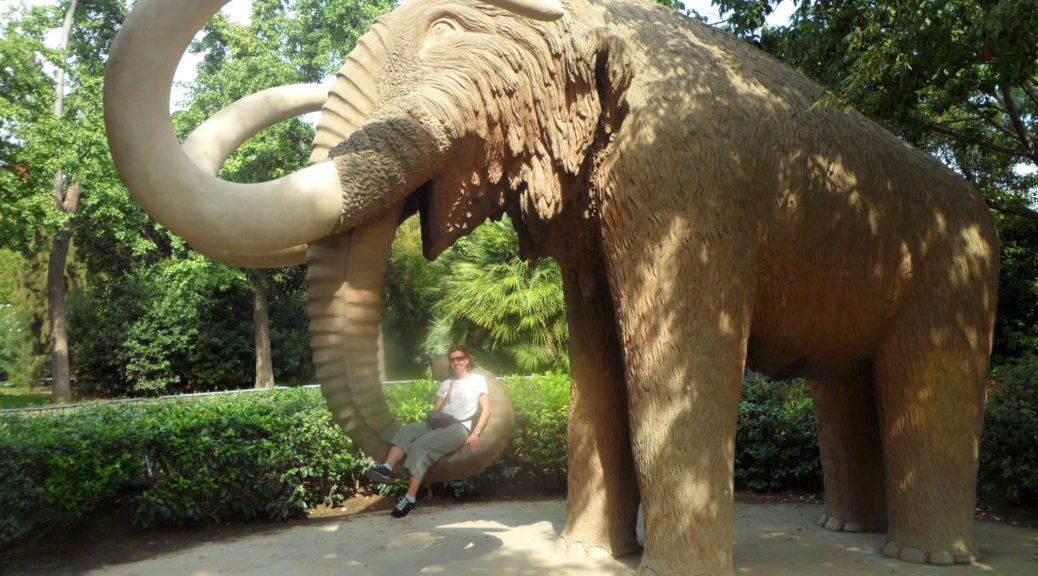BARCELONA
5-9 September 2013
The trip started with a giggle as an old dear struck up a conversation with us on the ramp to the plane as we had just cleared passport check at the boarding gate at ORT. She passed comment on how difficult it must be to travel with children, prompted by a man distracting his sobbing son by pointing at planes on the runway through the bay windows on the ramp. We nodded and mumbled vague but agreeable response.
When there was a second child further down the ramp *wailing*, the little old lady leaned in and told us proudly that her kids have never acted like that, not “to this day and they’re 59 and 54, mind.” She was quite conspiratorial when she shared the wisdom that in her day children were taught manners and “to be seen and not heard” and her kids were good as gold and always been complimented by people they’d visited. Just when we thought butter wouldn’t melt in the mouth of this sweet-as-sugar super-mom granny, she concluded the exchange with a “they need a bloody good klap, these little shits! And the shitty parents too!” You could have bowled me over with a feather!
The flights (from Joburg to Dubai for 8 hours and Dubai to Barcelona for 7) were easy, as they always are with Emirates – undoubtedly the best airline in the world at the moment. Their planes are all new, there’s more legroom, the entertainment is abundant and the food compares to real life meals. We had an excellent chicken fillet in creamy paprika sauce with baby potatoes on the first flight and shared a herby cajun chicken and a delicious creamy lamb curry on the second, with desserts like blueberry cheesecake and banana tart with apricot mousse. They do unnecessarily fussy concoctions of this and that, but still manage to please a limited-list eater like me.
Sadly, they do continental breakfasts, which really let down an otherwise flawless execution… especially when accidentally served the Arabic mese (olives, artichokes, hummus and tapanade) instead of the deli platter (ham and cheese with croissant and preserves), which still wasn’t very exciting… but much better!
Lixi and RoRo were at the gates and waiting when we landed at El Prat. They’d flown in from London Stansted and the hour delay on their side had worked in their favour as they’d ended up landing just before us.
We decided to grab a cab to take us to our digs rather than brave the public transport system with all our luggage. 30 Euros later we were deposited at our home for the weekend – “Kate’s Place” that we’d booked on www.airbnb.co.uk for a bargain price bearing in mind its view of the very famous Sagrada Familia. The special rate was offered so that Kate could vet her prospective tenants in their willingness and ability to look after her cat, Muffin. After some back and forthing – telling the story of who we are, why we’re coming to Barcelona and our views on flat life and pets – it was quite a sense of achievement to have passed the audition and been granted the reservation.
Kate is an extremely gracious host and had even been so kind as to provide a bottle of Cava (sparkling wine), ice cold beers, plate of jamon (Iberian cured ham), bowl of olives and bag of kettle-fried crisps for us to snack on while she inducted us to the flat, the cat and the sights of Barcelona, which she circled and highlighted on a city map she had for us. She really went above and beyond, spending well over an hour giving us advice, answering our questions and sharing her travel stories.
Armed with a plan and a map, we hit the streets of Barcelona. Kate chaperoned us to the corner, where we got to see Sagrada Familia up close, right there on our corner… with a Burger King and a KFC manning the opposites. Two major To Do items so close to home… oh yes, and that famous Gaudi churchy thing. 😉
Not often referred to by its full name, The Temple Expiatori de a Sagrada Familia is a massive privately-funded Roman Catholic church. Considered to be the master work of 19th century Catalan architect Antoni Gaudi, it is one of Barcelona’s top attractions with its interesting detail, Christian symbolism and 18 striking spindle towers.
There are 2 major roads that run inland vertical from the seafront – the beautiful Passeig de Sant Joan and the vibey Las Ramblas. Being about 16h00 – middle of the day Barcelona time – we opted for a leisurely stroll down Passeig Sant de Joan. It’s so easy to find and, being a gentle downhill, so easy to do that the daunting length of it on the map doesn’t translate in real life. It’s a really lovely avenue, enjoyed by many on foot, bicycles and rollerblades, and dotted with interesting monuments along the way.
The furthest inland is the Monument of Doctor Robert, which is open for children to climb and play on, which is far more laissez faire than most places where precious landmarks are kept arms’ length from appreciative eyes lest they be damaged or defaced. This open policy seems to have paid off as there appears to be a mutual respect from graffiti artists, who only tag on gates and grills and not on the beautiful brickwork. Very civilised indeed.
Next milestone down Passeig de Sant Joan was the Arc de Triomf, which was the same sort of archy thing as the one in Paris, but much smaller and it was pedestrians rather than cars that passed beneath it on the wide road, which wound all the way downhill to the Zoo at the t-junction at the bottom. In the Zoo Parc de Ciutadella was a huge statue of a mammoth (called, rather uncreatively, ‘Mammuth’), whose curled hanging trunk makes a perfect nest for a photograph. Around the corner from that was the Cascada Fountains, with their enormous wishing pool and winding escalier on either side leading up to the enormous arches with gaudy chariot and charging horses orange-gold statues on top. It was a bit much, to be frank, and would be easily and forgettably housed in the Lost City!
In desperate need of a rest from the long walk, Villa Olimpica glistened like an oasis! We grabbed a table sea-side at Vitaminus and settled in for a local cervesa and some of the tapas we’d been told needed most urgent attention – patatas bravas (fried potato wedges with spicy garlic cream) and pa amb tomaquet (toasted bread rubbed with garlic and fresh tomato). Incredibly, the sun was still in full force even though it was well after 6pm and the beach was still full of people sunbathing and swimming. We left at about 20h00 and the sun was only really then starting to set properly.
Our plan from there was to wind our way back to the apartment through Born, which is known for being Bohemian and teeming with restaurants and bars. This was no understatement and we were spoilt for choice as we wound our way through charming roads, alleyways and placas, stopping for a cava here and bits and pieces of tapas there (most notably jamon and nachos in La Ribera). Of course, when we got home our road was still quite lively so we had to stop in and support the local shopkeepers.
We washed down the jamon, pimento padron and calamari rings with ice cold cervesas and soaked in the lively atmosphere, with people eating dinner around us, as normal, at 23h00. All the while our holiday cat Muffin surveyed us from his spot on the balcony overlooking the central placa. Sadly, I had a headache from the cava (and likely the long day on top of a long journey) so headed to bed, but Lix and RoRo did us proud for a little while longer.
FRIDAY | BARCELONETA
Day 2 began, as every day should, with a natural awakening and a gentle ease into the day with couch time and some laughs with good friends. High on the list of priorities was a breakfast forage (seeing as we technically hadn’t had dinner the night before… although we had had sooo much tapas). The day had been declared Beach Day, so the only requirement for breakfast spot was that it had to be en route to the sea. Super simple seeing as half of Barcelona seems to be restaurants and cafés!
We took a turn past Sagrada Familia (already having to decided we were not going to bother with the hours-long queues and hefty entry fee) and stopped at a pavement café to share a selection of bikini (toasties) and bocadilla (baguettes) at La Pedreta. The ice cold bottled choc milk stole the show though!
Kate had advised us that the smartest idea was to get a Metro T10 pass (10 trips for 10 Euros) seeing as there was a Metro station on our corner and the whole of the inner city is comprehensively covered by the network of lines. The ticket entitles access on busses and trains too. There were loads of other intricacies that add benefit – like each journey being open for 1 hour 15, so if you’re doing a quick to and fro, you can get it count as a single click – but really the economy and convenience were a strong enough proposition on their own.
We took the yellow line down to Barceloneta and started our walking tour (downloaded from the internet, what did we do before it?!) with a visit to the Barceloneta Mercat (market). Quite uninspiring inside with all the fresh fruit, veg and seafood you’d expect, but quite impressive outside with its rooftop bank of solar panels that provide 40% of its power requirements.
Barceloneta wasn’t given good recommendation anywhere – neither Internet nor personal references – so we were expecting cramped and dirty streets, smelly and noisy. This was actually what put us off staying in Barceloneta, when our original envision was a beachy weekend in Barcelona. It was not like that at all. It was charming, had broad pedestrian-only roads with trees and benches and was definitely a strong contender to house me on future visits.
The beach was also much better than it was painted to be, with a perfect stretch of powdery (if not a bit chalky) sand and lovely shoreline… which we admired from one of the cafés dotted along the beach. Prime table right on the sand, the view was perfect… well, except for the people. This part of the beach – Playa de Sant Miguel seemed to be more touristy so the bodies were mostly white and dimpled, in stark contrast to the slim and trim orangey-brown Spanish ones. Heaven only knows how they all stayed in such good shape with all the tapas being perpetually consumed, but their brazen victory over modesty (and more jean shorts hot pants than can be believed) leaves no doubt whatsoever.
In need of tapas top-up, we took a break from our beach-watching to pop into a gorgeous old taverna called Can Ramoneta (a traditional restaurant serving freshly-caught fish and seasonal local produce from its 250 year old house location). We indulged in some jamon, pimentoes fritos and deep fried brie en route to the next beach, Playa de la Barceloneta, where we spent the rest of the afternoon frolicking and basking (under our 6 Euro beach brolly).
Then it was time to eat. Again. We had planned to eat an early dinner at La Fonda on Moll de Gregal, which was recommended by Kate as having decent food and a reasonably priced set menu, so much so that it’s frequented by as many locals as tourists. We got ourselves a table, ordered a jug of sangria, but were put off by our table neighbours, a couple of Cockney girls who were so unimpressed by their food that they were paying up and leaving despite only picking on their meals.
Sounded like they were ill-fated overall though since it was the one’s hen do and their third amigo had broken her collarbone, had stitches in her head and was covered in bruises from their misadventures the previous night. We counted ourselves lucky for the narrow escape (from poor food and these accident-magnets), bid them adieu and headed back to the Can Ramoneta to see if they had fideua (paella made with noodles instead of rice, which Catalunya is known for).
Sadly, the luck had rubbed off and Can Ramoneta was between meal settings so, while they could feed us, it would be amid waiters unlaying day settings and replacing them with night ones. Hardly optimal.
We decided instead to move in the direction of the famous Las Ramblas and seek supper along the way. We found instead an Irish pub called Paddy Lane. It was primely sited overlooking Passeig de Colom and Guinness and Cava were the order of the sundowners! We had such a good time, we even forgot to log on our Guinness Index! 🙁
Wanting to maintain some sense of decorum, I negotiated a pizza from the Italian restaurant next door to be delivered to our pavement table at Paddy’s and we were soon chomping down on mozzarella and pepperoni in not-so-traditional Catalan (or Irish) style.
It did the trick though and spirits were high as we entered the Barri Gotic, stumbling upon a wonderful rock bar called Rock and Rolla. Christian was thrilled when the (at first) taciturn barlady allowed him several requests for his favourite band to be played on the bar’s sound system. The barlady took a shine to us when we upped our 3 shot order of Leche de Pantera (Pantera milk, similar to the milk tarts we have at home, creamy and topped with cinnamon) to a full litre jug and settled in, clearly enjoying ourselves.
We didn’t have much left in us thereafter to fully explore Las Ramblas, but we did crawl the length of it and caught the tube home at Diagonal.
SATURDAY | PASSEIG DE GRACIA AND LAS RAMBLAS
Christian and I awoke, as always, starving. Since the others weren’t awake yet, we had a protein shake (in wildly romanticised “chocolate mousse dessert” flavour) to maintain good humour. Being Saturday there was, of course, rugby that needed watching and the prearrangement was to watch SA vs Australia ( being played in Brisbane, so televised at midday) at the Michael Collins Irish pub around the corner from the apartment.
Unable to do this on an empty stomach, we had to go past Burger King en route for a cheese burger and chips. Worth every penny of the R200 fortune we paid for 2 medium combo meals!
While the boys watched the rugby, Lixi and I missioned to
Europcar at Estacio de Barcelona -Sants to change my car booking. We were supposed to collect the car on Sunday, but at 20 Euros a day for parking, it didn’t make sense to collect the car a day before we really needed it! Having mastered the Metro system it was child’s play there and back – and more fun for me than rugby anyway!
Then we hit the Passeig de Gracia – a veritable shopping mecca and just all round pretty place to be. Wide roads with broad pedestrian island in the middle, tree-lined, lots of pavement cafés, just more of the same awesome we were getting used to seeing everywhere really! We did more atmosphere -soaking than shopping, but did pop into firm favourites like Mango and Zara.
Interspersed between the shops were some Gaudi gems. He was the architect fella who was responsible for really putting Barcelona on the map. It would seem that he initiated a one-man decorating wave and transformed the city with the buildings, trimmings, park and viaduct he imagined and realised. I say “realised” since those things he actually completed, unlike the Sagrada Familia which he designed and which is still being built today, with completion date unknown. He was a busy little bee in Barcelona, to be sure!
We oooed and aaaahed at La Pedrera, which added another tick to our UNESCO World Heritage Site list. Gaudi was very averse to straight lines and this building particularly has a wobbly quality from the wavy balconies that frame the outside of the building. He designed it this way because he wanted everyone in the building to get to know each other, so the exterior construction is such that residents can easily interact and communicate with each other. Obviously things were a little different in 1912 when the building was completed.
We got down the Passeig and stopped for a wettie in the “heart of Barcelona”, Placa de Catalunya, when we got more wettie than we bargained for with the heavens opening. And when it rained, it poured! What a pity we’d chosen a poor spot, with overpriced uninspiring looking food… so we chanced it and finished our drinks when the rain seemed to ebb and dashed out into the road in the direction of Las Ramblas.
It was really only spitting so not terrible to get down the street to our next pit stop… yet another Irish pub! Called Cheers, the pub had the usual Irish charm decor and obligatory Guinness paraphernalia, but the music was so dire that we decided to rather brave the rain than suffer the earbashing. So we made a mad dash past the Colom (which, even as a famous landmark, wasn’t worth stopping in the rain for a photo) and across the bridge to the shopping centre “island” in Port Vell called Rambla de Mar,to seek asylum in a lovely tapas bar (no surprises there) overlooking the old port sipping on cava and nibbling on croquettes.
Dinner had been predecided to be at El Chipirito downstairs in the same centre since it had been recommended to RoRo, so we proceeded forthwith and delighted on a seafood banquet, watching an enormous cruise ship parallel park in the port, which is indeed a sight to be beholden!
Luckily the rain had cleared (we’d been told it would, Barcelona not being one to dwell on inclement weather) so we headed back up to Las Ramblas to find the Fairy Bar, which Kate had told us about. Bosc de les Fades was a bar in the city’s wax museum, that had been decorated within an inch of its life in the theme of a fairy grotto. It was dark inside, with walls that are made to feel like those of a cave, trees with hanging branches and leaves, a pond with a little bridge and little twinkling lights everywhere giving a magical glow to the place. Really nice spot – and cheaper than the other pubs we’d been to, which defies logic.
We wound down the day with a walk up Las Ramblas, stopping only to forage for croquettes (definitely overtaking jamon as our tapas du jour) at Burger King of all places. Divine! They tasted like mini toasted bacon and cheese sandwiches!
SUNDAY | ARC GUELL
Sunday began promisingly, with a delicious homemade breakfast courtesy of LoRo (name revised post revelation that he is in fact landed gentry with official title, Lord Robert Birkmyre Ross III) and we managed to avoid any vodka making its way into the OJ, as had been our downfall at breakfast in Venice 2010.
The day’s main attraction was to be a visit to Parc Guell, which is a garden complex designed by (none other than, you guessed it) Gaudi. Located in our home district, Gracia, the only mission to get there was the trek up El Carmen hill, although the built-in public escalators helped enormously. It was worth it though and highly recommendable as a “must do” in Barcelona.
The focal point of the park was the main terrace, surrounded by a long bench in the form of a sea serpent. The curves of the serpent bench formed a number of enclaves, creating a social atmosphere (which appears to be one of Gaudi’s big drivers). There were lots of good photo opps, including Gaudi’s house (now a museum), the lizard fountain, the mosaiced column hall that supports the terrace, the viaduct and of course the panoramic views of Barcelona and its bay from the large cross monument at the park’s highpoint.
Having only ever heard of Gaudi in passing (and even being artistically challenged, as I am), it was hard not to admire the chap and all that he did. There was not a conventional bone in his body and his ideas were of epic scale, translated ingeniously.
All this trekking and gawking wore off breakfast pretty quickly and a lunch on Passeig de Sant Joan was the next order of business.
Christian and I each ordered a grill platter of sausages and steak, which seemed like a bargain at less than the steak sandwich and including a beer and bread! But, as with most things that seem too good to be true, it was too good to be true and the steak was a translation error and wasn’t supposed to be included. The waiter/chef/barman/cleaner that was serving us was quite flustered, but did bring us a steak anyway, which made for a lovely – if not slightly unconventional – rare beef dessert.
Fed and watered, we were ready for the next round of adventure. Lix and LoRo were off to the Picasso Museum and we were going to take another turn past the Zoo, Cascades and Mammoth. The plan was to meet back at what we called The Antonio Banderas Monument, which is actually a monument to the martyrs of the 1714 revolution that happens to have the word Benderes inscribed on the main message. No matter, we knew what we meant.
Born is a gorgeous part of the city and Christian and I were quite happy to sit on the church steps at Placa de Santa Maria and people-watch to pass the time until our meetback. Being an apartment lifestyle, there are always loads of people out, eating, drinking, socialising and walking dogs. Lots to see and do. Their clocks are obviously very different too since there are kids out playing in the placas until all hours – close to midnight from what we saw while we were out.
We met at a very cool bar/restaurant by the “Antonio Banderas Monument” called Bastaix. We had wanted to go there a few times, but it had always been full, having only 3 keg tables with low milking stools outside and 6 or so tables inside. Downstairs was a gorgeous bodega (cellar restaurant) with 8 or 10 small tables and a skylight onto the placa, which looked like it would make for a memorable meal.
The last thing on the To Do list was to find a bar called the Quiet Man which Christian had spotted in the Lonely Planet guide. Located at the far side of the bottom of Las Ramblas, it was an easy walk through the Barri Gotic to get to the general area, but then a bit more of a challenge to get to the exact location because the smaller side roads weren’t marked on our (tourist) map. We did find it and it turned out to be (yet another) Irish pub. Anyway, when in Rome and all that, so we ordered a Guinness and scoured the local mag for a suitable venue for our last night together.
We decided on a rock bar called The Bollocks in Barri Gotic and decided on a rest and refresh at the flat as the interim plan – easily done by nipping back and forth on the Metro.
Before Bollocks we tried a last attempt at getting in the elusive Fideua (paella with spaghetti instead of rice), stopping in at a little diner on the corner before the bar. The others ordered Cava, which seemed quite ambitious in such a down-to-earth eatery, but not only did they have it, but it came with free tapita too. This included a side plate of Russian salad (peas, egg, carrot, mayo), tuna salad (tuna,onions, potatoes, peppers) and a delicious warm Spanish tortilla (potato bake sort of thing). In our second ordering mix-up of the day, the fideau never came, so we still haven’t had it!
We did enjoy Bollocks though. Possibly a little too much, which necessitated a taxi home and meant our evac morning started a little later than planned.
MONDAY
We opted to have our farewell breakfast at the placa opposite the Sagrada Familia to take last advantage and feasted on enormous Club Sandwiches and fry-ups.
Then it was home to pack up the last few things and say (long) goodbyes to Muffin before lumbering to the Estacio de Barcelona-Sants (on our trusty Metro) to collect our rental car to begin the roadtrip part of our Iberian adventure.
We really had a good time in Barcelona and while a lot of it was having the ideal flat (and cat) and perfect company, I reckon there was so much to love about Barcelona that anyone could enjoy it. It had made my Top 3 places in the world, alongside Berlin and Bratislava.
